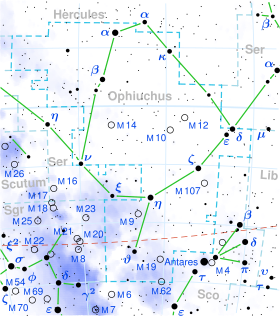44 Ophiuchi
| Observation data Epoch J2000 Equinox J2000 | |
|---|---|
| Constellation | Ophiuchus |
| Right ascension | 17h 26m 22.21749s[1] |
| Declination | −24° 10′ 31.1190″[1] |
| Apparent magnitude (V) | 4.16[2] |
| Characteristics | |
| Spectral type | kA5hA9mF1III[3] |
| U−B color index | +0.12[4] |
| B−V color index | +0.28[4] |
| Astrometry | |
| Radial velocity (Rv) | −37.20[5] km/s |
| Proper motion (μ) | RA: +0.10[1] mas/yr Dec.: −118.18[1] mas/yr |
| Parallax (π) | 39.22 ± 0.24 mas[1] |
| Distance | 83.2 ± 0.5 ly (25.5 ± 0.2 pc) |
| Absolute magnitude (MV) | 2.13[2] |
| Details | |
| Mass | 1.77[6] M☉ |
| Radius | 1.9[7] R☉ |
| Luminosity | 13[6] L☉ |
| Surface gravity (log g) | 4.15[8] cgs |
| Temperature | 7,559[8] K |
| Metallicity [Fe/H] | +0.30[2] dex |
| Rotational velocity (v sin i) | 78[6] km/s |
| Age | 1.028[8] Gyr |
| Other designations | |
| Database references | |
| SIMBAD | data |
44 Ophiuchi is a single[10] star in the constellation Ophiuchus. It has the Bayer designation b Ophiuchi, while 44 Ophiuchi is the Flamsteed designation. It is visible to the naked eye as a faint, white-hued star with an apparent visual magnitude of 4.16.[2] The distance to this object is approximately 83.2 light years based on parallax.[1] It is drifting closer to the Earth with a heliocentric radial velocity of -37.2 km/s,[5] and is predicted to come within 30 light-years around 585,000 years from now.[11]
This is an Am star with a stellar classification of kA5hA9mF1III,[3] indicating it has the luminosity class of a giant star with a spectrum that matches an A5 star based on the calcium K line, and an A9 star from the hydrogen and metal lines. It is around a billion years old[8] with 1.77[6] times the mass of the Sun and 1.9[7] times the Sun's girth. The star is radiating 13[6] times the Sun's luminosity from its photosphere at an effective temperature of 7,559 K.[8] It retains a moderately high rotation rate, showing a projected rotational velocity of 78 km/s.[6]
References
- ^ a b c d e f Van Leeuwen, F. (2007). "Validation of the new Hipparcos reduction". Astronomy and Astrophysics. 474 (2): 653. arXiv:0708.1752. Bibcode:2007A&A...474..653V. doi:10.1051/0004-6361:20078357. Vizier catalog entry
- ^ a b c d Anderson, E.; Francis, Ch. (2012). "XHIP: An extended hipparcos compilation". Astronomy Letters. 38 (5): 331. arXiv:1108.4971. Bibcode:2012AstL...38..331A. doi:10.1134/S1063773712050015. Vizier catalog entry
- ^ a b Gray, R. O.; Corbally, C. J.; Garrison, R. F.; McFadden, M. T.; Bubar, E. J.; McGahee, C. E.; O'Donoghue, A. A.; Knox, E. R. (2006). "Contributions to the Nearby Stars (NStars) Project: Spectroscopy of Stars Earlier than M0 within 40 pc--The Southern Sample". The Astronomical Journal. 132: 161. arXiv:astro-ph/0603770. Bibcode:2006AJ....132..161G. doi:10.1086/504637.
- ^ a b Mallama, A. (2014). "Sloan Magnitudes for the Brightest Stars". The Journal of the American Association of Variable Star Observers. 42: 443. Bibcode:2014JAVSO..42..443M.Vizier catalog entry
- ^ a b Gontcharov, G. A. (2006). "Pulkovo Compilation of Radial Velocities for 35 495 Hipparcos stars in a common system". Astronomy Letters. 32 (11): 759. arXiv:1606.08053. Bibcode:2006AstL...32..759G. doi:10.1134/S1063773706110065.
- ^ a b c d e f Zorec, J.; Royer, F. (2012). "Rotational velocities of A-type stars". Astronomy & Astrophysics. 537: A120. arXiv:1201.2052. Bibcode:2012A&A...537A.120Z. doi:10.1051/0004-6361/201117691. Vizier catalog entry
- ^ a b Allende Prieto, C.; Lambert, D. L. (1999). "Fundamental parameters of nearby stars from the comparison with evolutionary calculations: Masses, radii and effective temperatures". Astronomy and Astrophysics. 352: 555. arXiv:astro-ph/9911002. Bibcode:1999A&A...352..555A. Vizier catalog entry
- ^ a b c d e David, Trevor J.; Hillenbrand, Lynne A. (2015). "The Ages of Early-Type Stars: Strömgren Photometric Methods Calibrated, Validated, Tested, and Applied to Hosts and Prospective Hosts of Directly Imaged Exoplanets". The Astrophysical Journal. 804 (2): 146. arXiv:1501.03154. Bibcode:2015ApJ...804..146D. doi:10.1088/0004-637X/804/2/146. Vizier catalog entry
- ^ "b Oph". SIMBAD. Centre de données astronomiques de Strasbourg. Retrieved 2019-06-21.
- ^ Eggleton, P. P.; Tokovinin, A. A. (September 2008). "A catalogue of multiplicity among bright stellar systems". Monthly Notices of the Royal Astronomical Society. 389 (2): 869–879. arXiv:0806.2878. Bibcode:2008MNRAS.389..869E. doi:10.1111/j.1365-2966.2008.13596.x.
{{cite journal}}: CS1 maint: unflagged free DOI (link) - ^ Bailer-Jones, C. A. L. (March 2015). "Close encounters of the stellar kind". Astronomy & Astrophysics. 575: 13. arXiv:1412.3648. Bibcode:2015A&A...575A..35B. doi:10.1051/0004-6361/201425221. A35.

